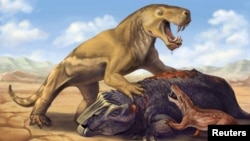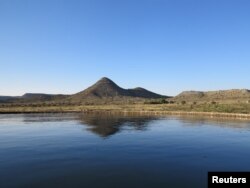A recent study says fossil remains of a top meat-eating animal living 250 million years ago, which had only been found in the world’s northern half, also lived in South Africa.
The scientists all have links to South Africa. They reported on fossils of a large ancestor to today’s mammals called Inostrancevia. The creature had only been known from fossils found in Russia near the Artic Sea until the new fossils were discovered at a farm in central South Africa.
The fossils suggest that Inostrancevia left its native area and moved about 12,000 kilometers over a period of hundreds or thousands of years. During that period, most of the world’s big landmasses were connected in what scientists call Pangea.
Inostrancevia filled the ecological place of a top meat-eating animal in South Africa that had been missing after four other species had died out.
"However, it did not survive there long," said Christian Kammerer. He is a scientist with the North Carolina Museum of Natural Sciences. Kammerer studies fossils and was the lead writer of the research published in Current Biology.
"They have no living descendants, but they are a member of the larger group called synapsids, which includes mammals as living representatives," Kammerer added.
Kammerer noted that Inostrancevia and all of its closest relatives disappeared in the mass extinction called "the Great Dying." The event took place at the end of what Earth scientists, or geologists, call the Permian Period.
Scientists believe that life on Earth was under pressure about 250 million years ago. Some scientists say volcanic activity in today’s Russian area called Siberia warmed Earth temperatures. It caused up to 90 percent of species to die out.
Inostrancevia is part of a group of animals called protomammals that combined reptile-like and mammal-like features. It was three to four meters long and had a large, long head with a set of huge teeth it used to kill and eat other animals. If the animals were small enough, Inostrancevia swallowed them whole.
Inostrancevia was structured differently from both reptiles and mammals but was usual for protomammals. It carried itself in a way that was neither flat to the ground like reptiles nor standing tall like mammals. It also lacked facial muscles found in mammals and did not produce milk.
"Whether these animals were furry or not remains an open question," Kammerer said.
The mass extinction happened over about one million years. It led to the rise of dinosaurs during the following Triassic Period.
The scientists noted that top meat-eating animals are especially affected by extinction because they require the most food and space.
The researchers said they see similarities between the Permian mass extinction and today’s climate change problem.
Pia Viglietti is with the Field Museum in Chicago. She helped write the study. She said unlike the animals that came before us during the Permian Period, “we actually have the ability to do something to prevent this kind of ecosystem crisis from happening again.”
I’m Gregory Stachel.
Will Dunham reported this story for Reuters. Gregory Stachel adapted it for VOA Learning English.
________________________________________________________________________
Words in This Story
fossil –n. the mineralized remains of an animal or plant that lived a very long time ago
species – n. a group of animals or plants that are similar and can produce young animals or plants
extinction – n. the state or situation that results when something (such as a plant or animal species) has died out completely
mammal – n. a class of animal that feeds milk to its young and that usually has hair and special ear bones
descendant – n. a plant or animal that is related to a particular plant or animal that lived long ago
feature – n. an important part, quality, or ability
fur – n. the hairy coat of an animal especially when it is soft and thick
ecosystem – n. everything that exists in a particular environment
_______________________________________________________________________
What do you think of this story?
We want to hear from you. We have a new comment system. Here is how it works:
- Write your comment in the box.
- Under the box, you can see four images for social media accounts. They are for Disqus, Facebook, Twitter and Google.
- Click on one image and a box appears. Enter the login for your social media account. Or you may create one on the Disqus system. It is the blue circle with “D” on it. It is free.
Each time you return to comment on the Learning English site, you can use your account and see your comments and replies to them. Our comment policy is here.










Forum